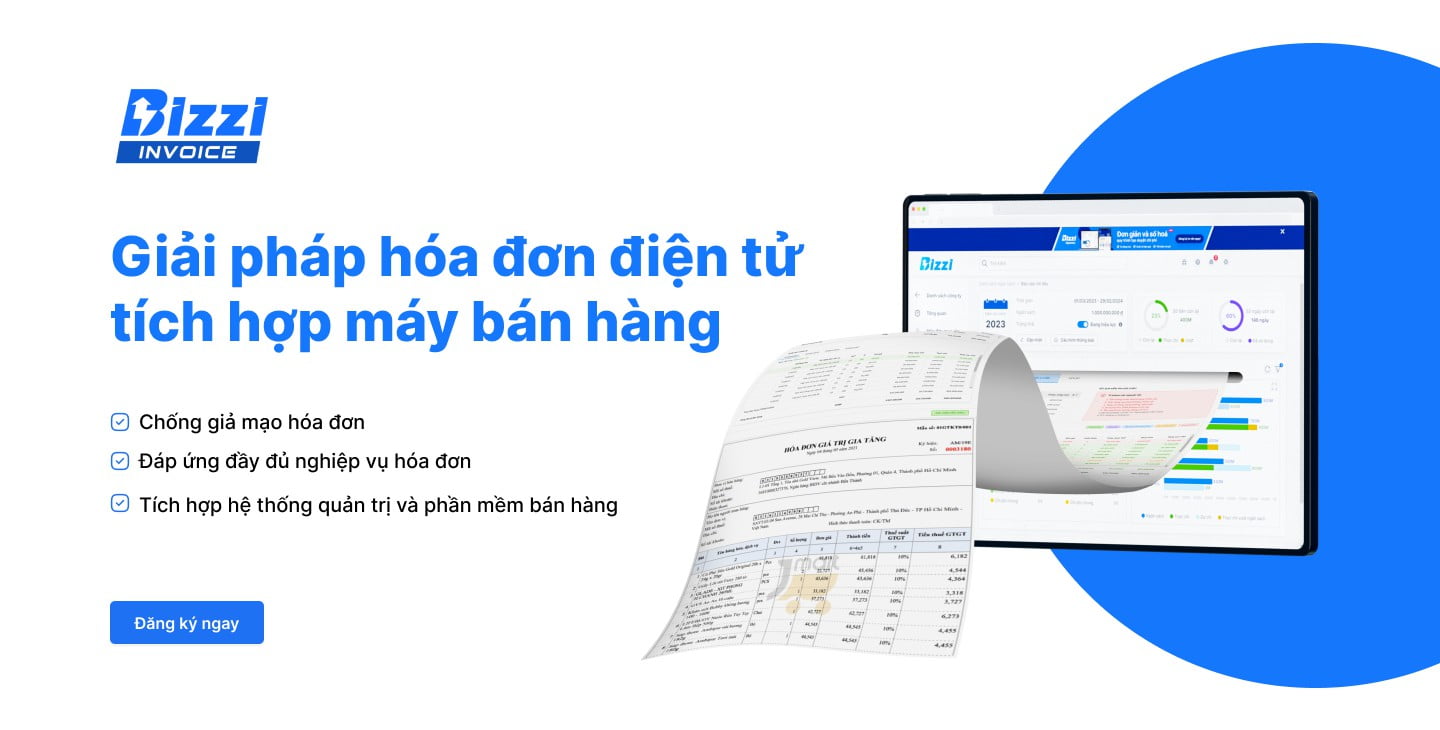In the process of business operations, errors on invoices are inevitable. To ensure accuracy and compliance with tax regulations, “adjusted invoices” become an extremely important legal and professional tool. So, what exactly is an adjusted invoice, when should it be issued, and what is the implementation process to avoid unnecessary risks?
This article, compiled by Bizzi specifically for business owners and accountants, will provide a comprehensive overview of the concept, specific cases, preparation process, as well as detailed accounting instructions for adjusted invoices according to current regulations.
1. What is a Reduction Adjustment Invoice?
A reduced adjustment invoice is an invoice issued to correct incorrect values recorded on a previously issued original invoice, including quantity of goods, unit price, total amount, tax rate or information related to economic transactions. This invoice is issued to ensure the accuracy of accounting books, reflect the true nature of economic transactions and comply with legal regulations.
- Define: Adjustment invoice is used when errors are discovered or there is an occurrence that changes (reduces) the buyer's payment obligations, such as reducing the quantity of goods delivered, reducing the selling price, or post-sales discount.
- Purpose: Helps businesses promptly correct errors on invoices, avoiding the risk of being penalized for invoices and taxes. At the same time, ensuring accounting data matches actual documents.
- Time of establishment: As soon as an error is discovered or when there is a need for adjustment, the business needs to issue an adjustment invoice with a written agreement between the relevant parties.
- How to write a discount adjustment invoice: The invoice must clearly state that it is an adjustment invoice, with information about the original invoice that needs to be adjusted (number, symbol, date of issue), specific adjustment content, and clearly state the reason for adjustment. Do not write negative numbers on electronic invoices according to Circular 78/2021/TT-BTC.
- How to issue a reduced adjustment invoice: After agreeing with the buyer and making an adjustment record, the seller will make an adjustment invoice according to the correct format of the electronic invoice software in use and send it to the buyer for tax declaration.
- Accounting for adjusted invoices: Accountants record the adjustment to reduce revenue, output VAT (if any) and update accounting books in accordance with the adjustment content. Accounting must be timely according to the provisions of the Accounting Law and current accounting standards.
- Legal basis: Relevant regulations are clearly stated in the Tax Administration Law No. 38/2019/QH14, Decree No. 123/2020/ND-CP, Circular No. 78/2021/TT-BTC, and detailed instructions from the General Department of Taxation.
Understanding and correctly implementing the process of preparing, exporting and accounting invoice adjustment reduction Not only does it help businesses avoid violating the law, it also contributes to improving transparency and efficiency in financial and accounting management.

2. Cases where Adjustment Invoices are required
Adjusted invoice is an important accounting tool that helps businesses adjust the value of goods and services issued on the original invoice when errors or changes occur that reduce the actual payment value. issue invoice adjustment must be carried out in accordance with regulations to ensure the validity of accounting records and avoid legal risks. Below are common cases that businesses need to pay attention to:
- Invoices created with errors increase value: When detecting that the sent electronic invoice has errors in the amount, unit price, tax rate or quantity... causing the value to increase more than the actual value, the enterprise needs to make a invoice adjustment reduction to reflect correctly. Depending on the situation, you can choose between Adjustment invoice or replacement bill as prescribed in Circular 78/2021/TT-BTC.
- Business discounts after invoice has been issued: If the business decides to reduce the price because the goods are of poor quality or do not meet the commitment, it needs to write adjustment invoice to update new values and at the same time account for revenue in accordance with actual sales.
- End of period trade discount: When the actual total discount is greater than the amount recorded on previous invoices, the accountant needs to issue invoice adjustment the difference to ensure transparency of revenue and discount policy.
- Adjustment of construction and installation revenue: In case the actual settlement value is less than the provisional price on the original invoice, the accountant needs to make adjustment invoice revenue difference and implementation Accounting for adjusted invoices respectively.
- Customer returns goods or services: When there is a situation where the customer returns the goods due to technical errors or not meeting requirements, the business needs to issue invoice adjustment To refund properly, record valid revenue reduction.
- Cancellation of contract with issued invoice: If the contract is cancelled in part or in whole, it is necessary to write adjustment invoice corresponding to the canceled value to update the actual payment status.
Understanding how to issue adjustment invoices and handle them correctly in each case helps businesses ensure compliance with regulations, financial transparency and avoid risks of being penalized by tax authorities.

3. Procedure and Method of Making Adjustment Invoices according to Circular 78/2021/TT-BTC
Making a reduction adjustment invoice in accordance with regulations is a mandatory requirement to ensure the legality and validity of accounting documents and avoid tax risks. Below are the procedures and detailed instructions on how to issue a reduction adjustment invoice according to Circular 78/2021/TT-BTC and Official Dispatch 1647/TCT-CS in 2023:
- Identify the reason for the adjustment: Before making an adjustment invoice, the accountant needs to clearly identify the original invoice that needs to be adjusted and the specific reason (errors in product name, unit price, tax rate, quantity, etc.). Discussing and agreeing with the buyer is also an important step before making the adjustment.
- How to write a discount adjustment invoice: Adjusted invoices must clearly show the content that needs to be adjusted, without repeating correct information. The invoice must be noted: “Adjustment for invoice Form No.… symbol… number… date… month… year…”. If adjusting the value, the negative sign (-) must be used according to regulations, showing a decrease in the declared value.
- Issue correct adjustment invoice:
- Use cases Electronic invoice without tax authority code: After completion, the seller signs and sends it directly to the buyer.
- Use cases Electronic invoice with tax authority code: The accountant signs and sends the invoice to the tax authority to get a code, then sends the invoice to the buyer.
- Record negative value when accounting for invoice adjustment: According to point e, clause 1, Article 7 of Circular 78/2021/TT-BTC, all adjusted values must be expressed in negative numbers to reflect reality. This is a mandatory requirement to help tax authorities easily compare and check.
- Error notification using Form 04/SS-HĐĐT: If the electronic invoice needs to be re-coded or processed in the direction of adjustment or replacement, the accountant must send Form 04/SS-HĐĐT to the tax authority. This notification must clearly show the original invoice information, the reason for adjustment and select the "Adjustment" item. The deadline for sending is the last day of the tax declaration period in which the adjusted invoice is generated.
- Note on invoices made according to old regulations: If the invoice is made according to old documents (Decree 51/2010/ND-CP, Circular 32/2011/TT-BTC...), when it is necessary to make a reduction adjustment, it is not allowed to make a reduction adjustment invoice. Instead, it must be alternative electronic invoicing to ensure compliance with the provisions of Clause 6, Article 12, Circular 78/2021/TT-BTC.
Understanding how to issue a reduced adjustment invoice not only helps accountants accurately handle errors that arise, but also contributes to optimizing the cost control process and tax compliance. To ensure accurate preparation and accounting of reduced adjustment invoices, businesses should apply an electronic invoice solution with automatic error warning features and direct adjustment support, as Bizzi is implementing.

4. Adjustment Invoice Reduction in the Context of Enterprise Cost Management and Software Systems
In practice of business cost management, invoice adjustment reduction plays an important role, especially for the buyer who is the unit receiving the input invoice. The processing and Accounting for adjusted invoices not only affects costs and inventory but also determines the accuracy of financial reports. Along with that, automation software platforms like Bizzi provide optimal solutions in controlling and updating information promptly.
- Impact on costs and inventory: Upon receipt invoice adjustment reduction, the value of goods, operating expenses or cost of goods sold will decrease accordingly. This depends on the intended use of the goods or services.
- How to account for adjusted invoices:
- If the item is in stock: Record decrease in inventory value (Debit account 111, 112, 331 / Credit account 156, Credit account 1331).
- If the item is sold: Record decrease in cost of goods sold (Debit account 111, 112, 331 / Credit account 632, Credit account 1331).
- If the goods have been put into production or consumption: Record the corresponding cost reduction (Debit account 111, 112, 331 / Credit account 154, 642,…, Credit account 1331).
- Special Adjustment Cases: Case invoice adjustment reduction arising from trade discounts, sales rebates or returned goods may be subject to separate accounting, requiring careful analysis in accordance with current regulations.
Bizzi – Comprehensive automation solution in processing adjustment invoices
- Process automation: Bizzi software is capable of automatically downloading invoices from multiple sources (email, electronic invoice software...), checking validity, extracting data and entering it into the approval flow according to the internal business process structure.
- Smart comparison: Bizzi allows comparing adjusted invoices with original invoices and related documents (receipts, orders, etc.), ensuring that the adjusted content is reasonable and has full legal basis.
- Limit errors: Minimize manual data entry errors and improve internal control efficiency with automated data validation and alerting systems.
Benefits of processing adjusted invoices with software like Bizzi
- Save time and effort on manual processing.
- Ensure accurate accounting data, minimizing the risk of errors.
- Support timely financial reporting, quick and accurate decision making.
- Increase control over costs, accounts receivable and inventory right from the document level.
Job issue invoice adjustment and accurate processing through a platform like Bizzi not only ensures regulatory compliance but also creates a solid data foundation for financial control and business cost optimization.

Conclude
Preparing and processing adjustment invoices is an important accounting and financial management task that businesses cannot avoid. Mastering legal regulations (especially Circular 78/2021/TT-BTC and Decree 123/2020/ND-CP) and following the correct procedures are necessary to ensure the accuracy and legal value of invoices.
In the context of digital transformation, the application of e-invoicing software and financial automation platforms such as Bizzi plays an important role in supporting businesses to effectively perform invoice adjustment and reduction operations, automate processes, minimize errors and enhance cost control. The integration of these platforms with the ERP system helps create a seamless flow of financial data, effectively supporting comprehensive business management.
Businesses register for trial at: https://bizzi.vn/dang-ky-dung-thu/

